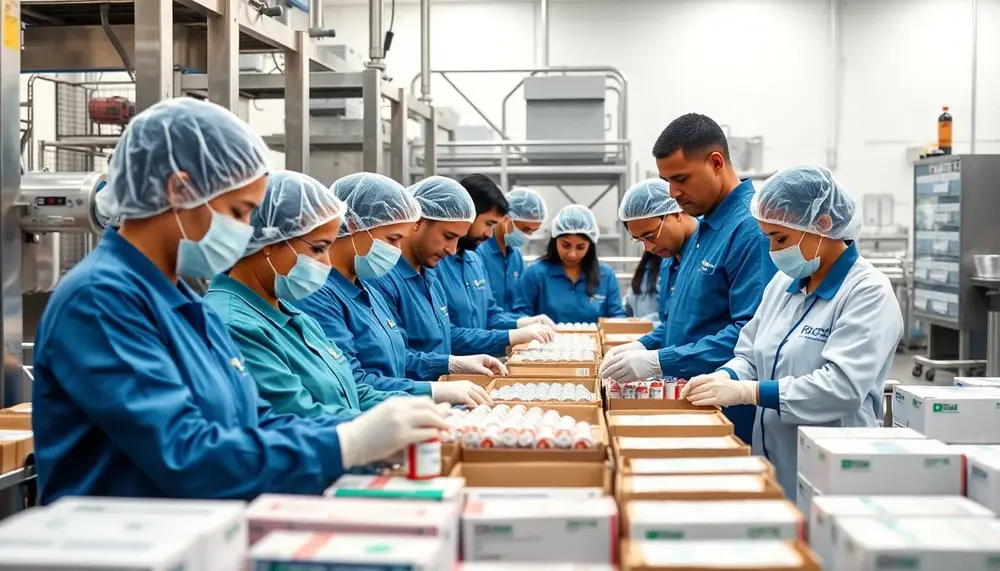Table of Contents:
Key Responsibilities of a Pharmaceutical Packaging Operator
Key Responsibilities of a Pharmaceutical Packaging Operator extend far beyond simply placing pills in a box or labeling bottles. In fact, this role is the backbone of pharmaceutical product integrity and patient safety. Operators must adapt quickly to changing production schedules and, sometimes, last-minute batch adjustments. You’ll often find yourself juggling several packaging lines at once, especially during high-demand periods—think flu season or sudden spikes in prescription needs.
Operators are entrusted with the calibration and fine-tuning of advanced packaging machinery. This means not just starting and stopping equipment, but also adjusting settings for different product formats—vials, blister packs, sachets, or ampoules—without missing a beat. A single misalignment can lead to costly product recalls, so attention to detail is non-negotiable.
- Batch Record Review: Before any packaging run, operators meticulously review batch records and production orders to confirm all specifications, including lot numbers, expiration dates, and packaging materials. This preemptive check helps catch errors before they snowball.
- Line Clearance and Changeover: Switching from one product to another isn’t just a matter of swapping labels. Operators must perform thorough line clearance, document every step, and ensure no cross-contamination. This is a regulatory must, not just a best practice.
- Real-Time Troubleshooting: When a machine jams or a sensor blinks red, operators are the first responders. Quick diagnostics and minor repairs—sometimes under pressure—are part of the daily grind. If you’re the type who likes to tinker, you’ll thrive here.
- In-Process Sampling: At regular intervals, operators collect samples for quality testing. These samples are often sent straight to the lab, and any deviation in weight, seal integrity, or appearance can halt the entire process until resolved.
- Regulatory Documentation: Every action—cleaning, adjustments, downtime—must be logged in real time. Regulatory agencies can request these records at any moment, so accuracy and timeliness are crucial.
- Collaboration with Quality Assurance: Operators don’t work in a vacuum. They coordinate with QA teams to investigate deviations, implement corrective actions, and support audits or inspections. Sometimes, you’ll even participate in root cause analysis meetings to prevent future hiccups.
In short, the role is a blend of technical know-how, regulatory awareness, and a dash of nerves of steel. The responsibilities are varied, demanding, and—let’s be honest—never boring. If you crave a role where every shift brings new challenges and real impact, this is it.
Essential Skills and Competencies Required
Essential Skills and Competencies Required for a pharmaceutical packaging operator are a unique blend of technical, cognitive, and interpersonal abilities. While the machinery and processes are complex, it’s the operator’s skills that keep everything running smoothly, even when things get a bit chaotic.
- Rapid Adaptability: Operators must quickly adjust to shifting production priorities, unexpected equipment issues, or sudden changes in packaging requirements. The ability to stay calm and focused, even when the plan goes out the window, is invaluable.
- Visual Acuity and Manual Dexterity: Spotting minute defects in packaging or labeling—sometimes in a split second—demands sharp eyesight and steady hands. These aren’t just nice-to-haves; they’re essential for preventing costly errors.
- Process-Oriented Thinking: Understanding and following detailed standard operating procedures (SOPs) is second nature to top operators. They don’t just memorize steps—they grasp the “why” behind each action, which helps them spot inconsistencies before they escalate.
- Proactive Communication: Clear, timely updates to supervisors and team members can mean the difference between a minor hiccup and a major production halt. Effective operators don’t wait for problems to snowball—they speak up early and often.
- Basic Data Analysis: Interpreting production data, identifying trends, and making minor adjustments based on numbers is part of the daily routine. A knack for numbers, even at a basic level, is a real asset.
- Compliance Mindset: A strong internal compass for following rules, safety protocols, and documentation standards is non-negotiable. Operators must be comfortable with audits and inspections, knowing their records and actions will be scrutinized.
- Resilience and Stamina: The job can be physically and mentally demanding. Endurance—both on your feet and in your focus—keeps quality high, even during long shifts or repetitive tasks.
Operators who master these competencies become linchpins in the packaging process, trusted to keep products safe and operations humming, no matter what the day throws at them.
Pros and Cons of the Pharmaceutical Packaging Operator Role
| Pros | Cons |
|---|---|
| Vital to patient safety and product integrity | Physically demanding—prolonged standing and repetitive tasks |
| Exposure to advanced machinery and technology | Requires strict adherence to rules and detailed documentation |
| Opportunities for career advancement and specialization | Work under strict environmental and cleanliness protocols |
| Often includes on-the-job training—pharma experience not always required | Shift work common—may include nights, weekends, or holidays |
| Active involvement in quality assurance and improvement | High-pressure during production surges or audits |
| Valued for proactive communication and problem-solving skills | Exposure to noisy environments and mandatory protective clothing |
| Stable, growing industry with frequent demand for operators | Continuous training required to keep up with evolving regulations |
Typical Working Conditions and Environment
Typical Working Conditions and Environment for pharmaceutical packaging operators are shaped by strict industry standards and the relentless pace of production. These professionals usually work in cleanrooms or controlled environments, where air quality, temperature, and humidity are carefully regulated. You’ll notice right away: there’s no room for dust, clutter, or even the tiniest contaminant. Protective clothing—think gowns, gloves, hairnets, and sometimes even face masks—is standard, and not just for show. Every item you wear is there to keep the product pure and the process compliant.
Shifts can be long, often organized in rotating patterns that include nights, weekends, or holidays. The hum of machinery is a constant companion, and the environment can get noisy, though ear protection is provided when needed. Operators may stand for extended periods, moving between workstations, sometimes in tight quarters. The workflow is fast-paced, and deadlines are real—if a batch needs to go out, there’s little room for delay.
- Lighting: Bright, even lighting is the norm, minimizing shadows and making it easier to spot defects or inconsistencies.
- Temperature: Expect a cool, stable climate—comfort is secondary to product stability.
- Safety Protocols: Emergency stops, safety signage, and regular drills are part of the daily routine, reinforcing a culture of vigilance.
- Break Areas: Separate from production zones, these spaces offer a brief respite but require a full change of attire before re-entering the cleanroom.
All in all, the environment is engineered for precision and safety, demanding both focus and adaptability from everyone on the floor. If you’re the type who thrives in structured, high-stakes settings, you’ll likely find the rhythm oddly satisfying.
Qualifications and Experience Needed
Qualifications and Experience Needed for a pharmaceutical packaging operator role are, in most cases, straightforward but not to be underestimated. A high school diploma or equivalent is the minimum educational requirement. Some employers, though, lean toward candidates with vocational training or certificates in manufacturing technology, process operations, or a related technical field. These credentials can give you a leg up, especially in facilities with advanced automation or digital tracking systems.
- Previous Manufacturing Experience: While not always mandatory, hands-on experience in a regulated production environment—such as food, cosmetics, or chemicals—can be a real asset. Employers often favor applicants who have demonstrated reliability and consistency in similar settings.
- GMP Familiarity: Direct experience with Good Manufacturing Practice (GMP) guidelines is highly valued. Even basic exposure to GMP principles, whether through previous jobs or short courses, shows you understand the importance of compliance and product safety.
- Technical Aptitude: Comfort with operating, adjusting, and maintaining machinery is essential. Some companies may require candidates to pass mechanical reasoning or aptitude tests as part of the hiring process.
- On-the-Job Training: Many employers provide structured onboarding programs. These can range from a few days to several weeks, covering equipment operation, safety protocols, and documentation standards. Adaptability and a willingness to learn are often considered just as important as prior experience.
- Physical Readiness: Candidates should be prepared for tasks that involve standing, lifting, and repetitive movements throughout their shift. Some roles may require a pre-employment physical or drug screening.
For those looking to advance, additional certifications—such as Six Sigma Yellow Belt or specialized packaging technology courses—can open doors to supervisory or technical specialist positions down the line.
Step-by-Step Example: A Day in the Life of a Pharmaceutical Packaging Operator
Step-by-Step Example: A Day in the Life of a Pharmaceutical Packaging Operator
Let’s walk through a typical shift, from clock-in to clock-out, to give you a real sense of what happens behind the scenes.
- Pre-Shift Briefing: The day starts with a quick team huddle. Operators review the production schedule, discuss any special packaging runs, and get updates on equipment status or pending maintenance.
- Gowning and Entry: Next, it’s time to suit up. Following a strict gowning protocol, operators don cleanroom attire and sanitize hands before entering the packaging area. No shortcuts—every step is checked.
- Line Preparation: The operator inspects the assigned packaging line, checks for leftover materials, and verifies that all tools and documentation are in place. Any discrepancies are flagged immediately.
- Start-Up Checks: Before running the first batch, the operator completes equipment checks, calibrates sensors, and confirms all safety interlocks are functional. If anything’s off, production waits until it’s fixed.
- Production Run: As packaging begins, the operator monitors machine performance, replenishes materials, and keeps a close eye on output quality. They also record key process data and flag any out-of-spec results.
- Mid-Shift Sampling: At scheduled intervals, samples are pulled for lab analysis. The operator ensures samples are labeled and delivered promptly, then updates the batch record accordingly.
- Routine Cleaning: Short cleaning breaks are scheduled to prevent build-up of dust or product residue. The operator follows detailed cleaning instructions and logs each activity.
- Changeover Procedures: If a new product or packaging format is scheduled, the operator initiates a line changeover. This involves removing all previous materials, cleaning the area, and documenting the process before restarting.
- End-of-Shift Wrap-Up: At shift’s end, the operator completes final equipment checks, updates production logs, and participates in a debrief with the incoming team. Any unresolved issues are handed over for follow-up.
Each day brings a mix of routine and surprises, but structure and attention to detail keep everything on track. It’s a rhythm that’s both demanding and, for many, surprisingly satisfying.
Quality Control and Compliance in Packaging Operations
Quality Control and Compliance in Packaging Operations is the silent guardian of pharmaceutical integrity. Every packaging run is underpinned by a web of checks, verifications, and regulatory safeguards that go far beyond the visible production line. Here, the stakes are high: even a minor deviation can compromise patient safety or trigger a costly recall.
- Critical Control Points: Operators must identify and monitor specific stages where errors are most likely—think seal integrity, fill volume, or label accuracy. These points are documented in advance and reviewed for every batch.
- Serialization and Traceability: Each product unit receives a unique identifier, allowing full traceability from raw material to finished package. This process, often automated, is vital for anti-counterfeiting and rapid response in case of recalls.
- Environmental Monitoring: Air quality, temperature, and humidity are tracked in real time. Deviations trigger immediate investigation, as environmental shifts can affect product stability and sterility.
- Compliance Audits: Internal and external audits are routine. Auditors may review records, observe processes, or even conduct surprise inspections. Operators must be audit-ready at all times, with documentation that is current and complete.
- Deviation Management: If an out-of-spec event occurs, operators initiate a deviation report. This launches a formal investigation, root cause analysis, and corrective action—often involving cross-functional teams.
- Ongoing Training: Regulatory standards evolve, so operators participate in regular training sessions. These updates cover new regulations, emerging risks, and changes in best practices.
Ultimately, robust quality control and unwavering compliance are what separate world-class pharmaceutical packaging operations from the rest. They ensure every patient receives a safe, effective product—every single time.
Career Growth and Advancement Opportunities
Career Growth and Advancement Opportunities for pharmaceutical packaging operators are more dynamic than many might expect. Entry-level roles often serve as a launchpad for broader careers in pharmaceutical manufacturing, quality assurance, or even regulatory affairs.
- Specialization: Operators can move into specialist positions focused on advanced machinery, automation, or new packaging technologies. Mastery of cutting-edge equipment is in high demand as the industry modernizes.
- Supervisory Roles: With proven reliability and leadership skills, operators may progress to team lead or shift supervisor positions. These roles involve managing personnel, coordinating schedules, and ensuring operational targets are met.
- Cross-Departmental Mobility: Experience in packaging can open doors to related departments such as production planning, supply chain logistics, or process validation. Companies often value internal candidates who already understand GMP environments.
- Professional Development: Many employers support further education, certifications, or participation in industry workshops. Credentials in lean manufacturing, Six Sigma, or pharmaceutical technology can accelerate advancement.
- Long-Term Prospects: Ambitious operators sometimes transition into roles in quality management, compliance, or continuous improvement, leveraging their frontline experience to shape company policy and process innovation.
In short, a pharmaceutical packaging operator role is rarely a dead end; it’s a stepping stone to a variety of rewarding career paths within a resilient and ever-evolving industry.
Frequently Asked Questions About Pharmaceutical Packaging Operator Roles
Frequently Asked Questions About Pharmaceutical Packaging Operator Roles
-
Is prior pharmaceutical experience required to become a packaging operator?
No, but it can be advantageous. Many companies offer comprehensive on-the-job training for candidates with a strong work ethic and technical aptitude, even if they come from outside the pharmaceutical sector. -
Are there opportunities for overtime or flexible scheduling?
Yes, overtime is common during peak production periods. Some employers also offer flexible shift patterns, though this varies by company and location. -
What are some common challenges new operators face?
Adapting to the pace of production, mastering unfamiliar equipment, and learning to follow strict documentation procedures can be tough at first. Most new hires adjust within a few months with proper support. -
Do packaging operators interact with other departments?
Absolutely. Operators often collaborate with maintenance, logistics, and IT teams to resolve issues or coordinate workflow changes, fostering a cross-functional environment. -
Is physical fitness important for this job?
Yes, a reasonable level of physical fitness is helpful, as the role may involve standing for long periods, lifting materials, and moving between workstations throughout the shift. -
Can packaging operators suggest process improvements?
Definitely. Many companies encourage operators to share ideas for efficiency or quality enhancements, and some even reward innovative suggestions that are implemented.
FAQs About Pharmaceutical Packaging Operator Roles
What are the main responsibilities of a pharmaceutical packaging operator?
Pharmaceutical packaging operators are responsible for setting up, operating, and monitoring packaging machinery, ensuring product quality and accurate labeling, maintaining strict hygiene protocols, and documenting production activities to meet regulatory compliance.
Which skills are essential for success in this role?
Key skills include technical aptitude, attention to detail, adaptability, strong communication, manual dexterity, compliance focus, and the ability to thrive in fast-paced production environments.
What qualifications or experience are required to become a packaging operator?
A high school diploma or equivalent is usually required. Previous experience in manufacturing—especially in regulated industries—and familiarity with Good Manufacturing Practices (GMP) are advantageous but often not mandatory due to available on-the-job training.
What does a typical work environment look like for pharmaceutical packaging operators?
Operators usually work in cleanrooms with controlled temperature, humidity, and air quality. The role involves wearing protective clothing, working in shifts (including nights and weekends), and following strict safety and hygiene protocols in a fast-paced environment.
Are there career advancement opportunities in this field?
Yes, packaging operator roles offer advancement opportunities, such as specializing in advanced equipment, moving into supervisory or cross-departmental positions, or pursuing further education and certifications for broader career growth in the pharmaceutical industry.






